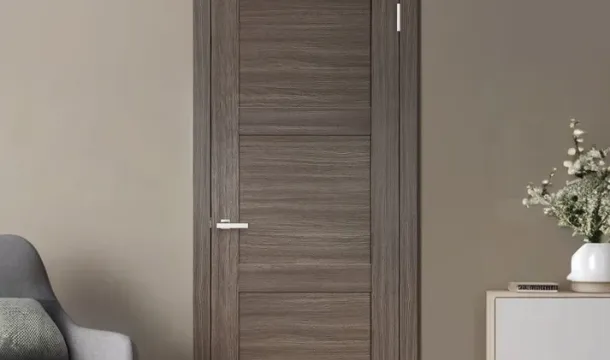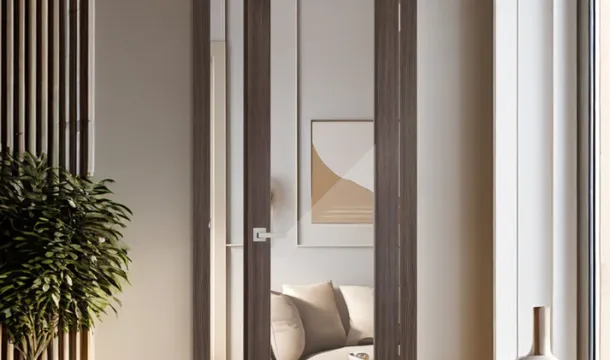Materials Used in Interior Doors: Differences and Features
Popular Articles
When choosing interior doors for your home, understanding the materials used in their construction is crucial. The material affects the door's durability, appearance, insulation, and price. There are several common materials used to make interior doors, each with its unique features, benefits, and drawbacks. In this guide, we'll explore these materials, how they differ, and what makes each one suitable for different needs.
Solid Wood Doors
Solid wood doors are made from natural timber and are known for their classic appeal and durability. They can be crafted from various types of wood, such as pine, oak, maple, or mahogany. These doors provide excellent sound insulation and have a substantial feel, making them a popular choice for those seeking both style and function.
Features and Benefits:
-
Durability: Solid wood doors are strong and can withstand wear and tear over time.
-
Aesthetic Appeal: They offer a timeless, elegant look that enhances the beauty of any home.
-
Sound Insulation: Due to their dense construction, they provide excellent soundproofing between rooms.
Drawbacks:
-
Cost: Solid wood doors are typically more expensive compared to other types of interior doors.
-
Weight: These doors are heavier, which can make installation more challenging and put extra strain on hinges.
Hollow Core Doors
Hollow core doors are made with a wooden frame and filled with a cardboard honeycomb or other lightweight material. The exterior is covered with a veneer or composite material. These doors are budget-friendly and widely used in homes where cost is a significant factor.
Features and Benefits:
-
Affordability: Hollow core doors are much less expensive than solid wood or solid core options, making them a cost-effective solution.
-
Lightweight: Their lighter weight makes them easy to install and ideal for areas where heavy-duty doors are not necessary.
Drawbacks:
-
Lower Durability: Hollow core doors are less durable and can be prone to dents or damage.
-
Poor Sound Insulation: They do not provide much soundproofing, which may not be ideal for bedrooms or home offices.
Solid Core Doors
Solid core doors are made with a composite or engineered wood core, covered with a veneer that mimics the appearance of solid wood. They offer a balance between the affordability of hollow core doors and the durability of solid wood doors.
Features and Benefits:
-
Sound Insulation: Solid core doors provide better soundproofing compared to hollow core doors, making them a good option for rooms requiring privacy.
-
Sturdiness: They are more resistant to damage and offer a more solid feel compared to hollow core doors.
Drawbacks:
-
Cost: While more affordable than solid wood doors, solid core doors are still pricier than hollow core alternatives.
-
Weight: Similar to solid wood doors, they can be quite heavy, which may make installation challenging.
MDF (Medium Density Fiberboard) Doors
MDF doors are made from wood fibers that are compressed together, creating a smooth, consistent material. MDF is often used in painted doors because it has no grain, resulting in a flawless finish. These doors are popular for their versatility and ease of customization.
Features and Benefits:
-
Smooth Finish: MDF doors are ideal for painting and can be easily customized to match any color scheme.
-
Affordability: They are more affordable than solid wood doors and provide a similar appearance when painted.
-
Resistance to Warping: Unlike solid wood, MDF is less prone to warping or cracking due to changes in humidity.
Drawbacks:
-
Susceptibility to Moisture: MDF doors can be damaged by moisture, making them less suitable for areas like bathrooms without proper sealing.
-
Less Durable: While they are more durable than hollow core doors, MDF doors are not as strong as solid wood.
Glass Doors
Interior glass doors are typically framed in wood or metal and feature glass panels that can be clear, frosted, or textured. These doors are often used to create a sense of openness and allow natural light to flow between rooms.
Features and Benefits:
-
Natural Light: Glass doors allow light to pass through, brightening up darker areas of the home.
-
Aesthetic Variety: They come in a variety of styles, from modern to traditional, and can be customized with different types of glass.
Drawbacks:
-
Privacy: Glass doors may not provide the level of privacy required for certain rooms, such as bedrooms or bathrooms.
-
Fragility: Glass is more fragile compared to other materials, which may require extra care to prevent damage.
Composite and Veneer Doors
Composite and veneer doors are made with a core of engineered wood or other materials, covered with a wood veneer that gives the appearance of a solid wood door. These doors are designed to provide the look of natural wood at a lower cost.
Features and Benefits:
-
Cost-Effective: They offer the appearance of solid wood without the high price tag, making them an attractive option for budget-conscious homeowners.
-
Stable: These doors are less likely to warp or crack compared to solid wood, making them a good choice for areas with fluctuating humidity levels.
Drawbacks:
-
Surface Wear: The veneer surface can be prone to scratching, and once damaged, it may be difficult to repair.
-
Less Authentic: While they mimic the look of solid wood, they do not offer the same natural feel or durability.
Choosing the right material for your interior doors depends on your needs, budget, and aesthetic preferences. Solid wood doors offer durability and classic style, but they come at a higher cost. Hollow core doors are affordable and lightweight, but lack durability and sound insulation. Solid core doors strike a balance, providing better insulation and sturdiness without the price of solid wood. MDF doors are ideal for those looking for a smooth painted finish, while glass doors create an open feel with natural light. Composite and veneer doors offer a cost-effective alternative that still provides the look of wood.
By understanding the differences between these materials, you can make an informed decision that best suits your home and enhances both its functionality and beauty.
Popular Articles

Soundproofing Interior Doors: Which Options Are Best for Your Home?

Choosing the Perfect Interior Doors for Your Canadian Home
